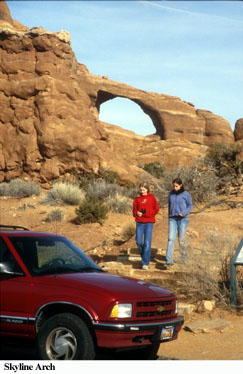
See our Moab area overview and Moab area hikiing articles.
By Golden Webb
The sky is salmon-pink, the air clear, cold—a crystalline winter morning in Arches National Park. I’m standing on the Tower Arch Trail halfway up the Salt Valley Anticline, watching the sun rise over the purest, cleanest display of rock and cloud and sky I’ve ever seen. Arches is an austere yet strangely sensuous desertscape, a 115-square-mile jewel that contains the largest concentration of natural stone arches in the world: over 2,000 at last count, including Delicate Arch, one of the Desert Southwest’s most recognizable icons.
As perfectly proportioned as Bo Derek, as enigmatic and freaky as that moon monolith in 2001: A Space Odyssey, Delicate Arch puts the lie to Bentley’s “fortuitous or casual concourse of atoms.” There’s purpose here, intelligent design—a message in stone from Yahweh, maybe, or some kind of crypto-geological receiver for interstellar transmissions from Betelgeuse. Or just rock with a hole in it. As Edward Abbey wrote: “There are several ways of looking at Delicate Arch. Depending on your preconceptions you may see the eroded remnants of a sandstone fin, a giant engagement ring cemented in rock, a bow-legged pair of petrified cowboy chaps, a triumphal arch for a procession of angels, an illogical freak, a happening . . . . If Delicate Arch has any significance it lies, I will venture, in the power of the odd and unexpected to startle the senses and surprise the mind out of their ruts of habit, to compel us into a reawakened awareness of the wonderful—that which is full of wonder.”
Cresting the wall of the Anticline, I drop into a rugged, sandy valley surrounded by ribs of rock and knobby towers chiseled from the Entrada Sandstone. Arches was shaped not only from above—by wind, water and ice—but also from below—by the powerful, glacier-like forces of an unlikely substance: Salt. The region was once part of the Paradox Basin, a 10,000-square-mile depression filled up over millions of years with a mile-thick deposit of “evaporites”—salt and gypsum crystallized from ancient seas. Two hundred million years of rock sediment, in 13 distinct layers—the Paradox, Honaker Trail, Cutler, Moenkopi, Chinle, Wingate, Kayenta, Navajo, Entrada, Summerville, Morrison, Dakota, and Mancos formations—washed down from the adjacent Uncompaghre Plateau and buried the salt core under. The resulting weight caused the salt to ooze like glacier ice, doming up the overlying rocks into folds and creating today’s fractured, evocative Arches landscape.
I arrive at the base of a large orange dune that runs up to a break in a curving, fin-carved wall. To my left the serried column of the Marching Men rises against the sky: three pillars atop a fractured bezel of slickrock. The sense of isolation is powerful here; there are probably mountain lion tracks nearby, pressed into the snowmelt. The dune spills out of a highland of fins and sandstone ridges; once on top, the walls pull close, and I slip between the folds. There’s a hush in the air: a feeling of being watched. I’m reminded of a passage in Edward Abbey’s Arches-inspired Desert Solitaire: “Is this at last the locus Dei? There are enough cathedrals and temples and altars here for a Hindu pantheon of divinities. Each time I look up one of the secretive little side canyons I half expect to see not only the cottonwood tree rising over its tiny spring—the leafy god, the desert’s liquid eye—but also a rainbow-colored corona of blazing light, pure spirit, pure being, pure disembodied intelligence, about to speak my name.” I round a corner, stop. No burning bush, just the final approach to Tower Arch: rolling mounds of pumpkin-orange sand, rippled by the wind; the twisted carcass of a juniper, reaching clawed hands up toward the winter sun; deep shadows cast by tons of sculptured stone.
I continue forward through the sand and shadows.
